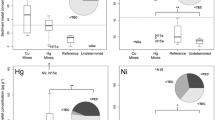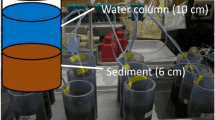Abstract
A laboratory study was conducted to investigate the role of the route of triphenyl phosphate (TPP) entry on its aquatic bioavailability and acute biological effects. Three TPP treatments were used for exposures of fish and invertebrates. These consisted of TPP dosed directly into water with and without clean sediment and TPP spiked onto sediment prior to aqueous exposures. Results of static acute toxicity tests (no sediment) were 0.78 mg/L (96-h LC50) for bluegill, 0.36 mg/L (48-h EC50) for midge, and 0.25 mg/L (96-h EC50) for scud. At 24 h, the sediment (1.1% organic carbon)/water partition coefficient (Kp) for TPP was 112. Use of this partition coefficient model to predict the sediment-mediated reduction of TPP concentration in water during toxicity tests resulted in a value that was only 10% less than the nominal value. However, the required nominal concentration of TPP to cause acute toxicity responses in test organisms was significantly higher than the predicted value by the model for both clay and soil-derived sediment. Direct spiking of TPP to soil minimized TPP bioavailability. Data from parallel experiments designed to track TPP residues in water through time suggest that sorption kinetics control residue bioavailability in the initial 24 h of exposure and may account for observed differences in LC50 and EC50 values from the sediment treatments.
Similar content being viewed by others
References
Bengtsson BE, Tarkpea M (1986) Bioaccumulation and effects of some technical triaryl phosphate products in fish and Nitocra Spinipes. Environ Toxicol Chem 5:858–861
Cleveland L, Mayer FL Jr, Buckler DR, Palawski DU (1986) Toxicity of five alkyl-aryl phosphate ester chemicals to four species of freshwater fish. Environ Toxicol Chem 5:273–282
Committee on Methods for Toxicity Tests with Aquatic Organisms (1975) Methods for acute toxicity tests with fish, macroinvertebrates, and amphibians, EPA-660/3-75-009, US Environmental Protection Agency, Washington, DC
Dawson GW, Jennings AL, Drozdowski D, Ridere E (1977) The acute toxicity of 47 industrial chemicals to fresh and saltwater fishes. J Hazard Mater 1:303–318
Howard PH, Padmakar GD (1979) Degradation of aryl phosphates in aquatic environments. Bull Environ Contam Toxicol 22:337–344
Huckins JN, Petty JD, England DC (1986) Distribution and impact of trifluralin, atrazine and fonofos residues in microcosms simulating a northern prairie wetland. Chemosphere 15:563–588
Karickhoff SW, Brown DS, Scott TA (1979) Sorption of hydrophobic pollutants on natural sediments. Water Res 13:241–248
Litchfield JT Jr, Wilcoxon F (1949) A simplified method of evaluating dose-effect experiments. J Pharmacol Exp Ther 96:99–113
Mayer FL, Adams WJ, Finley MT, Michael PR, Mehrle PM, Saeger VW (1981) Phosphate ester hydraulic fluids: An aquatic environmental assessment of Pydrauls 50E and 115E. In: Branson DR, Dickson KL (eds) Aquatic Toxicology and Hazard Assessment: Fourth Conference, ASTM-STP 737. American Society for Testing and Materials, Philadelphia, pp 103–123
Midwest Research Institute (1979) Assessment of the need for limitation on triaryl and trialkyl/aryl phosphates. EPA Contract Report, Contract No. 68-01-4313. US Environmental Protection Agency, Washington, DC
Muir DCG (1984) Phosphate esters. In: Hutzinger O (ed) The Handbook of Environmental Chemistry, Vol. 3-Anthropogenic Compounds. Springer Verlag, Berlin, pp 41–66
Muir DCG, Grift NP, Lockhart WL (1982) Comparison of laboratory and field results for prediction of the environmental behavior of phosphate esters. Environ Toxicol Chem 1:113–119
Saeger VW, Hicks O, Kaley RG, Michael PR, Mieure JP, Tucker ES (1979) Environmental fate of selected phosphate esters. Environ Science Technol 13:840–844
Sanders HO, Hunn J, Robinson-Wilson E, Mayer FL Jr (1985) Toxicity of seven polychlorinated biphenyl substitutes to algae and aquatic invertebrates. Environ Toxicol Chem 4:149–154
Smith CN, Leonard RA, Longdale GW, Bailey W (1978) Transport of agricultural chemicals from small upland piedmont watersheds. Environmental Protection Agency Ecological Research Series. EPA 600/3-78-056, National Technical Information Services, Springfield, VA
Spacie A, Hamelink JL (1985) Bioaccumulation. In: Rand GM, Petrocelli SR (eds) Fundamentals of Aquatic Toxicology; Methods and Applications. Hemisphere Publishing Corp, NY, pp 495–525
Terce M, Calvet R (1978) Adsorption of several herbicides by montmorillonite, kaolinite and illite clays. Chemosphere 1:365–370
Thomas JM, Yordy JR, Amador JA, Alexander M (1986) Rates of dissolution and biodegradation of water-insoluble organic compounds. Appl Environ Microbiol 52:290–296
Voice TC, Weber WJ Jr (1983) Sorption of hydrophobic compounds by sediments, soils and suspended solids. I. Theory and Background. Water Res 17:1433–1441
Author information
Authors and Affiliations
Rights and permissions
About this article
Cite this article
Huckins, J.N., Fairchild, J.F. & Boyle, T.P. Role of exposure mode in the bioavailability of triphenyl phosphate to aquatic organisms. Arch. Environ. Contam. Toxicol. 21, 481–485 (1991). https://doi.org/10.1007/BF01183868
Received:
Revised:
Issue Date:
DOI: https://doi.org/10.1007/BF01183868




